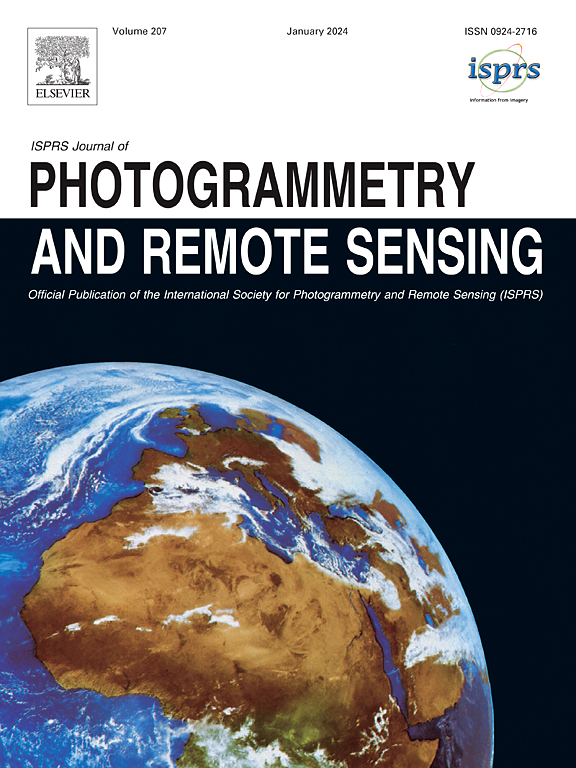Data fidelity-oriented spatial-spectral fusion of CRISM and CTX images
IF 10.6
1区 地球科学
Q1 GEOGRAPHY, PHYSICAL
ISPRS Journal of Photogrammetry and Remote Sensing
Pub Date : 2025-02-01
DOI:10.1016/j.isprsjprs.2024.12.004
引用次数: 0
Abstract
The Compact Reconnaissance Imaging Spectrometer for Mars (CRISM) is a Mars-dedicated compact reconnaissance imaging spectrometer that captures remote sensing data with very fine spectral resolution. However, the spatial resolution of CRISM data is relatively coarse (18 m), limiting its application to regional scales. The Context Camera (CTX) is a digital camera equipped with a wide-angle lens, providing a finer spatial resolution (6 m) and larger field-of-view, but CTX provides only a single panchromatic band. To produce CRISM hyperspectral data with finer spatial resolution (e.g., 6 m of CTX images), this research investigated spatial-spectral fusion of 18 m CRISM images with 6 m CTX panchromatic images. In spatial-spectral fusion, to address the long-standing issue of incomplete data fidelity to the original hyperspectral data in existing methods, a new paradigm called Data Fidelity-oriented Spatial-Spectral Fusion (DF-SSF) was proposed. The effectiveness of DF-SSF was validated through experiments on data from six areas on Mars. The results indicate that the fusion of CRISM and CTX can increase the spatial resolution of CRISM hyperspectral data effectively. Moreover, DF-SSF can increase the fusion accuracy noticeably while maintaining perfect data fidelity to the original hyperspectral data. In addition, DF-SSF is theoretically applicable to any existing spatial-spectral fusion methods. The 6 m CRISM hyperspectral data inherit the advantages of the original 18 m data in spectral resolution, and provide richer spatial texture information on the Martian surface, with broad application potential.
面向数据保真度的CRISM与CTX图像空间光谱融合
紧凑型火星侦察成像光谱仪(CRISM)是一种火星专用的紧凑型侦察成像光谱仪,能够以非常精细的光谱分辨率捕获遥感数据。然而,CRISM数据的空间分辨率较粗(18 m),限制了其在区域尺度上的应用。背景相机(CTX)是一种配备广角镜头的数码相机,提供更精细的空间分辨率(6米)和更大的视野,但CTX只提供单一的全色波段。为了获得更精细的空间分辨率(如6 m CTX图像)的CRISM高光谱数据,本研究对18 m CRISM图像与6 m CTX全色图像进行了空间光谱融合。在空间-光谱融合中,针对现有方法对原始高光谱数据保真度不高的问题,提出了一种面向数据保真度的空间-光谱融合(DF-SSF)新范式。通过对火星六个区域的数据进行实验,验证了DF-SSF的有效性。结果表明,CRISM与CTX的融合可以有效提高CRISM高光谱数据的空间分辨率。此外,DF-SSF在保持对原始高光谱数据的良好保真度的同时,可以显著提高融合精度。此外,DF-SSF在理论上适用于任何现有的空间光谱融合方法。6 m CRISM高光谱数据继承了原18 m数据在光谱分辨率上的优势,提供了更丰富的火星表面空间纹理信息,具有广阔的应用潜力。
本文章由计算机程序翻译,如有差异,请以英文原文为准。
求助全文
约1分钟内获得全文
求助全文
来源期刊

ISPRS Journal of Photogrammetry and Remote Sensing
工程技术-成像科学与照相技术
CiteScore
21.00
自引率
6.30%
发文量
273
审稿时长
40 days
期刊介绍:
The ISPRS Journal of Photogrammetry and Remote Sensing (P&RS) serves as the official journal of the International Society for Photogrammetry and Remote Sensing (ISPRS). It acts as a platform for scientists and professionals worldwide who are involved in various disciplines that utilize photogrammetry, remote sensing, spatial information systems, computer vision, and related fields. The journal aims to facilitate communication and dissemination of advancements in these disciplines, while also acting as a comprehensive source of reference and archive.
P&RS endeavors to publish high-quality, peer-reviewed research papers that are preferably original and have not been published before. These papers can cover scientific/research, technological development, or application/practical aspects. Additionally, the journal welcomes papers that are based on presentations from ISPRS meetings, as long as they are considered significant contributions to the aforementioned fields.
In particular, P&RS encourages the submission of papers that are of broad scientific interest, showcase innovative applications (especially in emerging fields), have an interdisciplinary focus, discuss topics that have received limited attention in P&RS or related journals, or explore new directions in scientific or professional realms. It is preferred that theoretical papers include practical applications, while papers focusing on systems and applications should include a theoretical background.
 求助内容:
求助内容: 应助结果提醒方式:
应助结果提醒方式:


